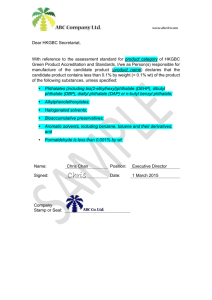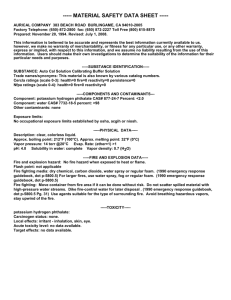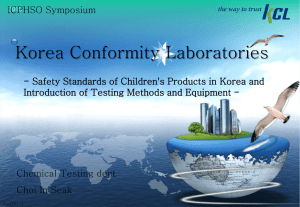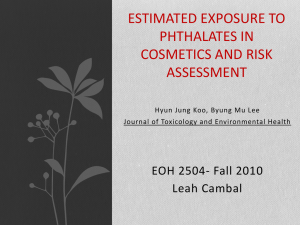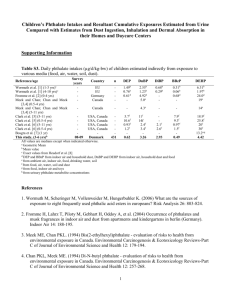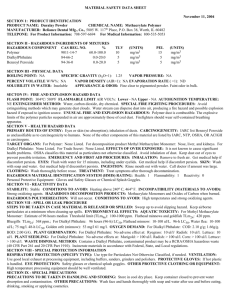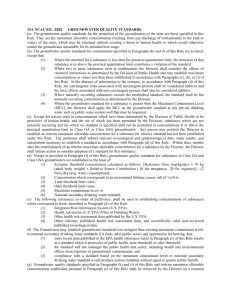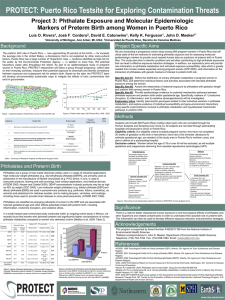Kira MacDougall - QSpace at Queen`s University
advertisement
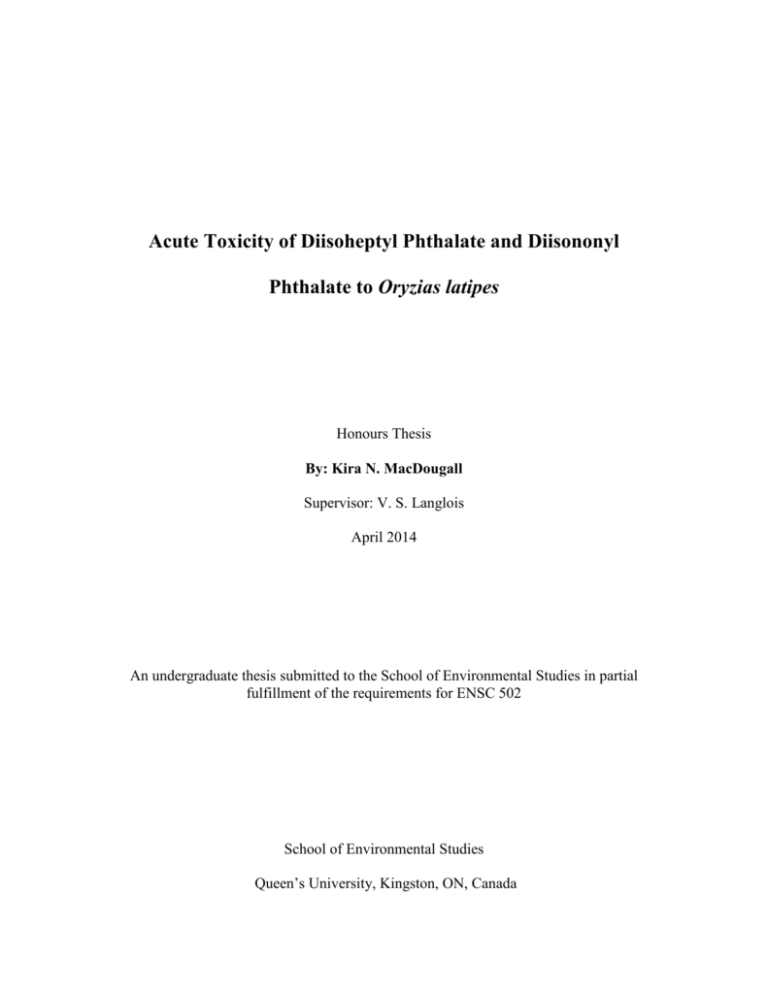
Acute Toxicity of Diisoheptyl Phthalate and Diisononyl Phthalate to Oryzias latipes Honours Thesis By: Kira N. MacDougall Supervisor: V. S. Langlois April 2014 An undergraduate thesis submitted to the School of Environmental Studies in partial fulfillment of the requirements for ENSC 502 School of Environmental Studies Queen’s University, Kingston, ON, Canada 2 ABSTRACT Phthalates are industrial chemicals used primarily as plasticizers to increase the flexibility of high molecular-weight polymers. These compounds are not covalently bound to the polymeric matrix but are instead distributed between the macromolecules of the polymer. Therefore, it is highly possible for them to leach out, inducing subsequent environmental contamination. It is important to learn more about how these toxicants are affecting the environment and vertebrate health. Diisoheptyl phthalate (DIHepP) and diisononyl phthalate (DINP) are among the list of substances that are being assessed by Environment Canada’s Chemical Management Plan. This study examines the effect of DIHepP and DINP on the Asian fish Oryzias latipes because it is subject to phthalate contamination in its natural habitat when phthalates leach out of plastic substances into the surrounding environment. At 1 day post hatching, fish were exposed to a range of environmentally relevant, low concentrations of DIHepP (0.037-0.3 µL/L) and DINP (0.012-0.1 µL/L) under semi-static conditions for 7 d. None of the treatments significantly induced mortality or malformation. Gene expression analysis was performed to assess possible endocrine disruption of these compounds. The transcripts of interest include deiodinase iodothyronine type 1 (dio1), thyroid hormone receptor β (trβ), steroidogenic acute regulatory protein (star), steroid 5-alpha reductase type 2 (srd5α2), and cytochrome P450 aromatase (cyp19β). The exposure did not have a statistically significant effect on gene expression. Taken together, these results indicate that exposure to DIHepP and DINP do not significantly affect mortality, malformation, or endocrine disruption in O. latipes at the tested concentrations. 3 ACKNOWLEDGEMENTS I would like to thank my supervisor Professor Langlois, for all I have learned from her and her continual support and guidance during all stages of this thesis. I am grateful to Professor Hodson for his valuable insight of Medaka health and the blue sac disease condition. I would like to acknowledge Connor Edington for his help throughout the duration of the exposure with animal care and sampling, Dr. Jing Zhang for his guidance during RNA extraction and his assistance with statistical analysis, and Sarah Wallace for preparing the primers used for this project and for her assistance with cDNA synthesis. I would like to thank Tash-Lynn Colson, Laura Gibson, Justine MathieuDenoncourt, and the rest of the Langlois lab team for their help during qPCR and statistically analysis. I would also like to acknowledge the animal care volunteers for their assistance in caring for the Medaka. In addition, I would like to thank Shane R. de Solla and Environment Canada for providing funding for this project. 4 TABLE OF CONTENTS ABSTRACT ................................................................................................................................... 2 LIST OF TABLE ........................................................................................................................... 6 LIST OF COMMON ABBREVIATIONS ................................................................................... 7 1. INTRODUCTION AND LITERATURE REVIEW .............................................................. 8 1.1 Phthalates as Aquatic Contamination ......................................................................................................8 1.2 Effects of Phthalates on the Endocrine System ................................................................................. 10 1.3 Oryzias latipes ............................................................................................................................................. 14 1.4 Hypotheses & Research Objectives ...................................................................................................... 14 2. MATERIALS AND METHODS........................................................................................... 17 2.1 Phthalate Exposure ..................................................................................................................................... 17 2.1.1 Chemicals and reagents .................................................................................................................... 17 2.1.2 Animal Husbandry and Breeding .................................................................................................. 17 2.1.3 Experimental Design of Phthalate Exposures ........................................................................... 18 2.1.4 Sample Collection and Malformation Analysis........................................................................ 18 2.2 Gene Expression .......................................................................................................................................... 19 2.2.1 mRNA Isolation.................................................................................................................................. 19 2.2.2 cDNA Synthesis and Quantitative Real-Time Reverse Transcriptase Polymerase Chain Reaction (qPCR) ........................................................................................................................................... 20 2.3 Data Analysis ............................................................................................................................................... 21 3. RESULTS ............................................................................................................................... 23 4. DISCUSSION ......................................................................................................................... 28 4.1 Mortality & Malformation ....................................................................................................................... 28 4.2 Gene Expression .......................................................................................................................................... 30 5. SUMMARY............................................................................................................................. 35 REFERENCES ............................................................................................................................ 36 5 LIST OF FIGURES Fig. 1. Chemical structure of diisoheptyl phthalate (DIHepP) and diisononyl phthalate (DINP)....................................................................................................................... 16 Fig. 2. Effect of DIHepP and DINP on mortality and malformation in O. latipes. .......... 24 Fig. 3. Picture of a healthy O. latipes and an O. latipes with BSD taken after the 7 d exposure .................................................................................................................... 25 Fig. 4. Expression of ef1α, dio1, trβ, star, srd5α2, cyp19β in O. latipes exposed to DIHepP and DINP .................................................................................................... 27 6 LIST OF TABLE Table 1. qPCR primers and assay conditions for genes of interest in O. latipes .............. 22 7 LIST OF COMMON ABBREVIATIONS BBP – Butyl benzyl phthalate BSD – Blue Sac Disease cyp19β - Cytochrome P450 aromatase DBP – Di-n-butyl phthalate DCHP – Dicyclohexyl phthalate DEHP – Di-(2-ethylhexyl)-phthalate DEP – Diethyl phthalate DIDP – Diisodecyl phthalate DIHepP – Diisoheptyl phthalate DINP – Diisononyl phthalate DMP – Dimethyl phthalate dio1 - Deiodinase iodothyronine type 1 EDC – Endocrine disrupting compound MMP – Mono-ethyl phthalate srd5α2 - Steroid 5-alpha reductase type 2 star - Steroidogenic acute regulatory protein TH – Thyroid hormones trβ – Thyroid hormone receptor β T3 – Triiodothyronine T4 – Thyroxine qPCR – quantitative real-time reverse-transcriptase Polymerase Chain Reaction 8 1. INTRODUCTION AND LITERATURE REVIEW 1.1 Phthalates as Aquatic Contamination Phthalates are industrial chemicals used primarily as plasticizers to increase the flexibility of high molecular-weight polymers. These compounds are not covalently bound to the polymeric matrix, but are instead distributed between the macromolecules of the polymer (Ganning et al., 1984). Therefore, it is highly possible for them to leach out, inducing subsequent environmental contamination. Phthalate molecules are present in a variety of products, including medical devices, children’s toys, building materials, food packaging, and clothing (Martino-Anderson & Chahoud, 2009). Most products contain approximately 30% di-(2-ethylhexyl) phthalate (DEHP) but some products contain up to 50% (Rank, 2005). Phthalates represent 69% of plasticizer use in the USA, 92% in Western Europe and 81% in Japan (Stringer et al., 2000). In 2008, global demand for phthalates exceeded 5 million metric tons (SRI Consulting, Inc. 2009). Given the largescale and widespread use of phthalates and that phthalates are not chemically bound to the polymer, it is not surprising that many phthalates, such as di-n-butyl phthalate (DBP) can be detected in air, soil and aquatic ecosystems (Shen et al., 2011). The median DEHP concentration in Europe, China, and North America are 0.00105, 0.00111, and 0.00027 µL/L, respectively (Bergé et al., 2013). Globally, phthalate contamination in surface water ranges from several microliters per liter, to several tens of microliters per liter (Bergé et al., 2013). The two phthalates used in this study are diisoheptyl phthalate (DIHepP) and diisononyl phthalate (DINP) (Fig. 1). As of 2013, these two chemical substances were placed among the list of substances being assessed by Environment Canada’s Chemical 9 Management Plan (Environment Canada, 2013). The goal of this plan is to obtain information on the effect of chemicals that were used prior to the Canadian Environmental Protection Act being enacted, and whose effects are unknown. Phthalates are esters of phthalic acid (an aromatic dicarboxylic acid) that differ from each other by the length of the carbon side chains. DIHepP has seven carbons, while DINP has nine. High molecular weight phthalates (six carbon alkyl chain lengths or greater) are ideal plasticizers due to their fluidity and low volatility (Patyna et al., 2005). Phthalates are lipophilic compounds with solubilities that range from greater than 5 X 106 mg/L for dimethyl phthalate (DMP) (C1 phthalate) to 0.038 mg/L for diisodecyl phthalate (DIDP) (C10 phthalate) (Staples et al., 2011). Previous studies have reported increased rates of malformation and mortality from phthalates. A 96 h acute exposure of X. laevis embryos investigating the effects of DBP, reported a statistically significant effect on malformation (Lee et al., 2005). In their experiment, concentrations of 0.1, 0.5, 1, 5, 10, and 15 µL/L DBP resulted in malformation rates of 7, 9, 15, 37, 51, 53, 90, and 100% respectively. In the following study conducted by Ghorpade et al. (2002), toxic effects of diethyl phthalate (DEP) were investigated in the freshwater fish, Cirrhina mrigala. The fish were treated with 25, 50, 75, and 100 µL/L (w/v) DEP. 100% mortality occurred in the 100 and 75 µL/L groups within 24 h. In the 25 and 50 µL/L DEP-treated group, there was 10% and 50% mortality respectively in 72 h. Environment Canada is requesting more research be performed to learn how DIHepP and DINP are interacting with the environment and whether they are affecting mortality, malformation, and endocrine disruption in target species. 10 1.2 Effects of Phthalates on the Endocrine System The endocrine system is a collection of glands that play a vital role in growth, development, and reproduction. An endocrine-disrupting chemical (EDC) is a compound that alters the homeostasis of hormonal control in an organism. When hormonal control is disrupted, signal transduction between the organism and its external environment may be compromised (Diamanti-Kandarakis et al., 2009). An EDC can be either natural or synthetic in nature. When the endocrine system is disrupted, growth, developmental, reproductive, and immune functions of an organism may be affected. In this study, the effects of DIHepP and DINP will be studied on transcripts of interest including deiodinase iodothyronine type 1 (dio1), thyroid hormone receptor β (trβ), steroidogenic acute regulatory protein (star), steroid 5-alpha reductase type 2 (srd5α2), and cytochrome P450 aromatase (cyp19β). These genes encode for proteins that affect both the thyroid hormone and the sex steroid pathways. Thyroxine (T4) and triiodothyronine (T3), collectively known as the thyroid hormones (THs), are critical to growth, development, and metabolism of vertebrates (McNabb & King, 1993). More specifically, these effects include regulating growth and differentiation of tissues and organs; regulating energy homeostasis, body temperature, and heart rate; and protein, fat, carbohydrate, and vitamin metabolism (Bowen, 2010). Therefore, disruption of the TH axis can cause severe impairment to the affected organism (Jugan et al, 2010). T4 and T3 are known to influence gene expression in virtually every vertebrate tissue (Bianco & Kim, 2006). T4 is the main secretory product of the thyroid gland and is relatively inactive when it first enters the bloodstream. One role of the hormone thyroxine 5’-deiodinase, is to convert T4 to T3 (Epstein & Brent, 11 1994). The interaction between T3 and the specific thyroid hormone receptors, TRα and TRβ, are primarily responsible for action of the THs (Sakurai et al., 1990). The genes dio1 and trβ were chosen for analysis to determine if the TH pathway was being affected by the presence of DIHepP and DINP in the water. In the absence and presence of TH, dio1 acts as a transcription repressor and activator, respectively (Heimeier & Shi, 2010). Thyroid hormone synthesis and signaling are important targets of endocrine disruptors such as polychlorinated biphenyls, perchlorates, and brominated flame-retardants, and phthalates (Jugan et al., 2010). For example, a study performed by Shen and colleagues (2011) measured the effects of mono-n-butyl phthalate (MBP) and DBP in Xenopus laevis (African Clawed Frog). X. laevis were exposed to 2, 10 and 15 µL/L for 21 days. It was concluded that the effects of DBP and MBP induced changes in the expression of selected thyroid hormone response genes: thyroid hormone receptor-beta (trβ), retinoid X receptor gamma (rxrγ), and alpha and beta subunits of thyroid-stimulating hormone (tshα and tshβ). Expression of trβ and rxrγ were down-regulated significantly at all concentrations of MBP and DBP compared with the control group. The mRNA level of tshβ increased significantly only in 10 and 15 µL/L MBP treated groups compared with the control group. These findings suggest the potential disruption of TH signaling by phthalate contamination. Kim et al. (2002) assessed the effects of endocrine disruption in Oryzias latipes (Japanese Medaka) exposed to DEHP. Fish were exposed to 0.001, 0.01, and 0.05 µL/L DEHP from hatching to 3 months of age. In this study, blood vitellogen was analyzed as a biomarker of hormonal disruption. Vitellogen is an egg yolk precursor protein expressed in the female livers of fish species (Robinson, 2008). Blood vitellogen is 12 synthesized in female livers and is stimulated by hormones such as 17-β-estradiol (Chen et al., 1986). It was concluded that DEHP reduced vitellogen levels in the blood of female fish: no effects were observed in males. Their research suggests that DEHP is an antiestrogenic compound in female O. latipes (Kim et al., 2002). In addition to the TH related pathway, some of the genes of interest in this experiment code for proteins that affect the sex steroid pathway. Sex steroids are steroid hormones that interact with androgen or estrogen receptors in vertebrates (Guerriero, 2009). Androgens and estrogens are the two main classes of sex steroids and are derived from dihydrotestosterone and estradiol, respectively. The precursor molecule cholesterol is converted into testosterone via a series of enzymatic steps within tissues such as the testis (Waterman & Keeney, 1992). The conversion of cholesterol into an intermediate molecule, pregnenolone, is largely controlled by star. (Kallen et al., 1998). The movement of cholesterol from the outer mitochondrial membrane to the inner mitochondrial membrane is facilitated by the star enzyme, which increases the availability of substrate for the synthesis of all steroid hormones (Miller, 1988). A study conducted by Ye and colleagues (2014) showed the upregulation of several genes in marine medaka (Oryzias melastigma), including star and cyp19α in a 6 month exposure of DEHP (0.1 and 0.5 µL/L) and monoethylhexyl phthalate MEHP (0.1 and 0.5 µL/L). In this study, star was chosen as a transcript of interest, as it is crucial in the conversion of cholesterol to testosterone, of which all sex steroids are derived. Testosterone acts through two main pathways: androgen (either directly or after 5α-reductase conversion to dihydrotestosterone) and estrogen (via aromatase conversion) (Pike, 2001). Enzymes coded for by srd5α2 catalyze the synthesis of the potent hormone 13 dihydrotestosterone from testosterone (Thigpen et al., 1993). Dihydrotestosterone is essential for androgen-mediated growth of tissues and for the formation of the male phenotype (Andersson et al., 1991). Mutations within the coding region of srd5α2 may block development of the male phenotype (Waterman and Keeney, 1992) and result in male pseudohermaphroditism, a condition in which external genitalia are phenotypically female at birth (Thigpen et al., 1993). The transcript of srd5α2 is expressed at high levels in androgen-sensitive tissue and was chosen as a gene of interest to study the androgen axis. In females, cyp19 encodes an enzyme involved in catalyzing the synthesis of estrogens and has been identified in many different animal phyla, including vertebrates (Chiang et al., 2001). In most teleost fish, two cyp 19 genes are present, cyp19α, expressed in the ovary, and cyp19β, expressed in the brain (Cheshenko et al., 2008). In the brain, androgens are converted into estrogens via aromatization (Chiang et al., 2001). It is believed that cyp19β is critical in the regulation of sexual differentiation and the female reproductive cycle in teleost fish (Cheshenko et al., 2008) and is the reason the cyp19β gene was chosen as a gene of interest. Finally, diihydrotestosterone and estradiol diffuse across the cell membrane and bind to androgen and estrogen receptors respectively, within the cell. Once the sex steroids bind to the receptor, they modulate the expression of many related genes (Nussey & Whitehead, 2011). Previous studies have investigated the effects of phthalates on genes involved in the sex steroid pathways. In utero exposure to DBP leads to a reduction in testosterone production by the fetal testis. Thompson et al. (2004) gavaged 12 pregnant rats daily with 500 mg/kg DBP. A significant decrease in testosterone production and mRNA expression 14 of scavenger receptor B1, side chain cleavage enzyme (P450scc), star, and cytochrome p450c17 were observed. Each of the genes demonstrated a similar relative expression level at both gestational day 17 and 18, but the mean percentage of expression of the four genes relative to the control was 46.4% and 15.4% in the gestational day 17 and 18 DBPexposed fetuses respectively (Thompson et al., 2004). This study shows that DBP is coincident with decreased transcription of several genes in the cholesterol transport and steroidogenesis pathways. 1.3 Oryzias latipes O. latipes are unique among common laboratory teleosts. The presence of highly polymorphic inbred lines, high fecundity, small adult size, ease of husbandry, and a relatively small sized (~800 Mb), completely sequenced genome, are reasons why O. latipes are extensively used in biological research and ecotoxicology studies (Takeda & Shimada, 2010). Its genome is approximately one-third the size of the human genome and less than half the size of the Danio rerio (zebrafish) genome. O. latipes is readily bred under laboratory conditions and reaches sexual maturity four to six weeks after hatching. O. latipes was chosen as the species of interest because it is subject to phthalate contamination in its natural habitat when phthalates leach out of plastic substances into the surrounding environment. 1.4 Hypotheses & Research Objectives O. latipes were exposed to a range of environmentally relevant, low concentrations of DIHepP (0.037-0.3 µL/L) and DINP (0.012-0.1 µL/L). These concentrations were chosen to reflect environmental conditions. It is hypothesized that 15 DIHepP and DINP will have a significant affect on mortality and endocrine disruption due to evidence from past environmental studies. However, after reviewing previous literature, it is hypothesized that there will not be a statistically significant effect on malformation. In a 96 h acute exposure of X. laevis embryos, there was only a 7% and 9% malformation rate at concentrations of 100 and 500 DBP respectively. The concentrations of phthalate in this study are higher than the concentrations being tested in the present study, and therefore it is hypothesized there will not be a statistically significant change between treatments. To test this hypothesis, gene expression analysis was performed in O. latipes. The transcripts of interest include dio1, trβ, star, srd5α2, and cyp19β. 16 A. B. Fig. 1. Chemical structure of A. diisoheptyl phthalate (DIHepP) and B. diisononyl phthalate (DINP). DIHepP and DINP are aromatic dicarboxylic acids that differ from each other by the length of their carbon side chains. 17 2. MATERIALS AND METHODS 2.1 Phthalate Exposure 2.1.1 Chemicals and reagents DIHepP, DINP, formaldehyde and ethyl 3-aminobenzoate methanesulfonic acid (MS-222) were obtained from Sigma-Aldrich, (Oakville, ON, CA). 2.1.2 Animal Husbandry and Breeding The adult fish were fed three times at 09:00, 12:00, and 18:00, once with brine shrimp (Pets and Ponds, Orillia, ON, CA) and twice with tropical fish flake (Pets and Ponds, Orillia, ON, CA). Water temperature and pH were kept between 24.8-25.6 °C and 7.0-7.5, respectively. A 16-h light/8-h dark photoperiod was used to maintain health of fish. Males and females were kept together in the same tanks to allow for daily egg production. Eggs were collected twice per day directly from the females by capturing the fish with a small mesh net and running the first finger and thumb gently along the length of the fish. Eggs were collected over a three-day timespan and placed in an embryorearing medium containing 1000 mg/L NaCl, 40 mg/L CaCl2, 30 mg/L KCl, and 160 mg/L MgSO4 to prevent bacterial infection. The eggs were placed in 19 X 65 mm glass vials (Thermofisher, Ottawa, ON, CA) and checked for hatchlings every 24 h. The water was fully replaced (100% renewal) every 24 h. The hatchlings were moved to a holding tank with dechlorinated water until 24 h post hatching, when the exposure began. O. latipes were kept at the Queen’s University Animal Care Facility (Kingston, ON, CA). Animal care and experimentation was performed according to the Canadian Council on Animal Care Guide to the Care and Use of Experimental Animals (1993) as well as the 18 policies and procedures established by the Queen’s University Animal Care Committee and the Canadian Council of Animal Care. 2.1.3 Experimental Design of Phthalate Exposures The highest concentration of DIHepP and DINP tested in this experiment was determined by performing a solubility test. Acetone (0.01%) is recommended by the Standard Guide for Conducting Early Life-Stage Toxicity Tests with Fishes (Environmental Protection Agency, 1996) and was chosen for this experiment. Larval fish were exposed to a geometric series of concentrations of DIHepP (0.037, 0.075, 0.15, and 0.3 µL/L) and DINP (0.012, 0.025, 0.05, and 0.1 µL/L). Stock solutions were prepared for DINP and DIHepP by mixing the total daily amount of phthalate required into 300 mL of distilled water. Both water and acetone were used as negative controls. At 1 d post hatching, fish were exposed to the solutions under semi-static conditions for 7 d. Each treatment was run in quadruplicate. Each jar contained 5 fish held in 70 mL of solution. Water and solution renewal were completed every 24 h. Dead fish were removed from each jar daily, counted, and placed in a 10% formalin solution for further analysis of malformation. 2.1.4 Sample Collection and Malformation Analysis After one week of exposure, the remaining fish were anaesthetized in a 100 mg/L MS-222 solution and scored for malformations under a Stereomaster dissecting microscope (Thermofisher, New Jersey, USA). Blue Sac Disease (BSD), was used for analysis of malformation, as BSD can be result from exposure to environmental contaminants, such as DIHepP and DINP. A modified BSD scoring method was used 19 (Lin, 2014) in this experiment. Blind analysis was conducted to remove observer bias. The fish were removed from the MS-222 and immediately placed in 1.5 mL tubes (Thermofisher, Ottawa, ON, CA) on dry ice, and stored at -80 °C until gene expression analysis was conducted. For water analysis purposes, 200 mL water samples were collected during the experiment to validate absolute and constant concentrations of the phthalates. Water samples were collected prior to the start of the exposure (0 h), after 24 h, and stored at -20 °C until further analysis. The water samples were not the scope of this honours thesis project, and thus data is not included. 2.2 Gene Expression 2.2.1 mRNA Isolation Three fish were pooled together to make one sample weighing approximately 0.0034 g. There were 6 replicates for each phthalate treatment and 8 replicates for each of the water and acetone controls. A commercially available kit, QIAGEN RNeasy Micro kit (Ottawa, ON, CA), was used to isolate RNA. The procedure was performed quickly to prevent RNA degradation. All steps were performed at room temperature. Samples were homogenized by sonication (Homogenizer MDL 150T 1/8 MT, Thermofisher, Ottawa, ON, CA) and centrifuged using the Sorvall Legend 21 Centrifuge (Thermofisher, Ottawa, ON, CA). A series of buffers and wash solutions were subsequently passed through the membrane of the column and discarded. RNA was quantified using the NanoDrop-2000 Spectrophotometer (Thermofisher, Ottawa, ON, CA) and stored at -80 °C in 1.5 mL tubes. 20 2.2.2 cDNA Synthesis and Quantitative Real-Time Reverse Transcriptase Polymerase Chain Reaction (qPCR) Specific Primers (Table 1) used in this study were developed using the National Center for Biotechnology Information (NCBI) Primer Blast. RNA samples were used as a template to synthesize complementary DNA (cDNA) using a commercially available kit (QuantiTect Reverse Transcripation Kit, QIAGEN, Ottawa, ON, CA). Primers and nuclease-free water were added to 1 µg RNA according to the manufacturer’s protocol. Samples were incubated for 2 min at 42 °C then placed on ice. Master Mix containing RNase-free water, gDNA Wipeout Buffer (Quantiscript), Reverse Transcriptase, Quantiscript RT Buffer, RT Primer Mix, and nuclease-free water was added to the solution. The samples were then placed in the thermocycler to incubate for 15 min at 42 °C and inactivated for 3 min at 95 °C. For each sample, 0.5 µg of complimentary (cDNA) was made. Finally, the samples were stored at -20 °C. cDNA was amplified and quantified by quantitative real-time reverse transcriptase polymerase chain reaction (qPCR). A BioRad CFX96 Real Time System qPCR (Mississauga, ON, CA) was used to assess the levels of gene expression in the samples. A serial dilution (1:4) was used to create the standard curves. Every plate contained a no template control (NTC) and a negative reverse transcriptase control (NoRT) to ensure the samples were not contaminated. A Master Mix was created with Promega GoTaq qPCR MasterMix (Madison, Wisconsin, USA), forward primer, reverse primer and nuclease free water and was added to each sample. Both the standard curves and the samples were run in duplicate. The thermocycler program included heating the samples to 95 °C for 3 min, cycles at 95 °C for 15 s, and finally cycles at 58 °C or 60 °C, depending on the gene 21 being analyzed. The genes of interest included srd5α2, cyp19β, trβ, dio1, and star. A 1:40 dilution was performed for trβ, dio1, and star and a 1:80 dilution was performed for srd5α2 and cyp19β. Gene expression was reported as fold changes relative to the water control. The results were normalized with elongation factor 1 (ef1α). This gene was chosen as the normalizing gene, as it did not change significantly between treatments. 2.3 Data Analysis After one week, the percentage of mortality was calculated for each replicate and the average calculated for each treatment. Each fish was examined for BSD at the end of the exposure. The malformations were calculated for each replicate by taking the sum of the malformations and dividing by the total number of individuals per treatment; the average was calculated for each treatment. A Fisher exact test was used to determine if there were statistical significance and differences among treatments in mortality and malformations. For gene expression data analysis, normality of the results was examined using a Goodness of Fit test. Homoscedasticity was verified using the Levene’s test. The Kruskal-Wallis test was used for genes trβ, dio1, and star, because the data were nonparametric. A one-way analysis of variance (ANOVA) was performed for each gene. The level of statistical significance was set at p < 0.05. 22 Table 1. qPCR primers and assay conditions for genes of interest in O. latipes. Complete list of target genes, primer sequences (5’-3’), annealing temperature (°C), amplicon size (bp) and optimized primer concentration (µM). Primer sequences were custom developed from NCBI Primer Blast. Legend: F, forward primer; R, reverse primer; srd5α2, steroid 5-alpha reductase type 2; cyp19β, cytochrome P450 aromatase; trβ, thyroid hormone receptor β; dio1, deiodinase, iodothyronine, type 1; star steroidogenic acute regulatory protein; ef1α, elongation factor 1. The primers were custom developed. Target gene Primer Sequence (5’ – 3’) Annealing temperature (°C) Amplicon size (bp) Primer Concentration ef1α F R F R F R F R F R F R AGTGGCTTTTGTCCCCATCT CACTGGCATTTCCGTCCTTG GACTTCGTGAATGTGCGTTGT GCTCTAATGATGCCCTTCTGCT ATCGTTCCTGTGCTCGTGG TGAAGAGGTTGGTGGGGTCT TGACCTTAGACTGCCTCCCA AGATCCCCCTCTGTCTGGGT AGTCTGGGTCTCGTTCTGTT CCCCAAGAGAAACACCGCTC CAAAGAAGCCGTCACCAACA ATGCTGGTCCTCTCCGTCTC 58 113 58 107 60 97 58 83 60 118 60 108 0.35 0.35 0.35 0.35 0.35 0.35 0.30 0.30 0.35 0.35 0.30 0.30 star srd5α2 cyp19 trβ dio1 23 3. RESULTS There was no statistically significant effect of DIHepP or DINP on malformation or mortality (Fig. 2). Malformation and morality were equal to or below 12.5% for each treatment. Results were not statistically significant for either malformation or mortality (p > 0.05). The malformation used in this experiment was BSD (Fig. 3). qPCR was used to determine the expression level of six genes, ef1α, dio1, trβ, star, srd5α2, and cyp19β (Fig. 4). Dissociation curves displayed a single peak for each gene, indicating there was no DNA contamination in the wells. All the NTC and NoRT wells showed no amplification. The calibration curve efficiency ranged from 90.4 to 113.8% and R2 was between 0.991 and 0.997. The control gene, ef1α, did not vary significantly among treatments (p > 0.05) and was therefore used as the normalizing gene. For the srd5α2 gene, mRNA expression levels were transformed by log10. Once normalized, the mean relative gene expression did not vary significantly between treatments for any gene (p > 0.05). There were no trends in the data. The water analyses were not a major purpose of this project and were not included. 24 Fig. 2. Effect of DIHepP and DINP on A. malformation and B. mortality in O. latipes. Data are expressed as mean + SD. Data were analyzed using a one-way ANOVA (n = 48); p > 0.05). 25 A B 1. 2. Fig. 3. Pictures of A. normal healthy O latipes from the water treatment and B. O. latipes with BSD from the 0.3 µL/L treatment, taken after the 7 d exposure. Legend: 1. A cranial-facial deformity; 2. Yolk sac edema. 26 A ef1α A. 6 Relative mRNA Levels 1 4 2 0 CC. trβ 0 0 0 0 0 0 0. D star D. 3 Relative mRNA Levels 6 4 2 0 2 1 0 e 7 5 0 0 2 5 0 0 er at eton .03 .07 .15 .30 .01 .02 .05 .10 0 0 0 0 0 0 0 0 W c A DIHepP DINP e 7 5 0 0 2 5 0 0 er at eton .03 .07 .15 .30 .01 .02 .05 .10 0 0 0 0 0 0 0 0 W c A DIHepP DINP Treatments (ppb) Treatments (ppb) F. F cyp19β E. E srd5α2 4 Relative mRNA Levels 2.50 Relative mRNA Levels 0 0 e 7 7 5 5 0 12 2 5 5 0 0 er 1 3 at to . . 0. 0.1 0 0. 0. 0. A DIHepP DINP Treatments (ppb) n W . . 0 . 0 . 75 . . . A c t t 37 2 5 0 0 er one a 0 0 15 30 01 02 05 10 W e 0 0 0 0 0 0 0 0. DIHepP DINP Treatments (ppb) 03 0 ce Relative mRNA Levels 2 Relative mRNA Levels 27 B.B dio1 1.25 0.00 2 0 e 7 5 0 0 2 5 0 0 er at ton 03 07 15 30 01 02 05 10 W ce 0. 0. 0. 0. 0. 0. 0. 0. A DIHepP DINP Treatments (ppb) W e 7 5 0 0 2 5 0 0 er at eton .03 .07 .15 .30 .01 .02 .05 .10 0 0 0 0 0 0 0 0 c A DIHepP DINP Treatments (ppb) Fig. 4. Expression of A. ef1α, B. dio1, C. trβ, D. star, E. srd5α2, F. cyp19β in O. latipes exposed to DIHepP and DINP. Expression levels were measured after the 7 d exposure. Relative mRNA levels for each sample was analyzed using qPCR. Bars represent the mean fold change + SE. The scales on the y-axis vary between genes. Data were analyzed using a one-way ANOVA (n = 5-6); p > 0.05). 28 4. DISCUSSION 4.1 Mortality & Malformation According to the ASTM (1998), in order for this experiment to be valid, mortality in the controls must be below 10%. A mortality rate of 5% and 0% for the water control and acetone control, respectively, was found. In our study, DIHepP and DINP did not have a statistically significant effect on mortality at the tested concentrations. A comparable aquatic toxicology study performed by Adams et al. (1995) on freshwater and marine species, reported similar findings. In their study, 14 different phthalates, including DINP, were tested at concentrations ranging from 0.21 to 377 µL/L. It was concluded that phthalates with alkyl chain lengths of six carbon atoms or more, such is the case with DIHepP and DINP, were not acutely toxic at concentrations approaching their respective aqueous solubility. Furthermore, Chikae et al. (2004) investigated the effects of DEHP (0.00001, 0.0001, 0.001, and 0.01 µL/L) in O. latipes after a 3 wk period. These concentrations are comparable to the concentrations used in our experiment and despite a longer exposure period, there was still no effect on mortality. In contrast, Mankidy et al. (2013), studied the biological impacts of DEHP, DEP, di-n-butyl phthalate (DBP), and butyl benzyl phthalate (BBP) in developing Pimephales promelas (Fathead Minnow) embryos. Exposure to 1 µL/L DEHP resulted in 30% mortality, while exposure to 10 µL/L DEP caused 52% mortality. Exposure to DBP or BBP at 1 µL/L did not cause significantly greater mortality compared to the controls. The embryos were exposed to the phthalate until 96 h post hatching. These concentrations were 10 and 100 times greater than the concentrations tested in our experiment and may explain why mortality was observed in this experiment compared to the present study. In the following study 29 conducted by Ghorpade et al. (2002), toxic effects of DEP were investigated in the freshwater fish, Cirrhina mrigala. The fish were treated with 25, 50, 75, and 100 µL/L (w/v) DEP. 100% mortality occurred in the 100 and 75 µL/L groups within 24 h. In the 25 and 50 µL/L DEP-treated group, there was 10% and 50% mortality respectively in 72 h. These concentrations are 250 to 1000 times higher than the concentrations used in our experiment and may account for the difference in toxicity. In conclusion, studies that tested phthalates at concentrations similar to our tested concentrations, no effect on mortality was observed. However, in studies that tested phthalates at concentrations greater than 0.1 µL/L, mortality was significantly elevated. Therefore, if our study investigated the effect of DIHepP and DINP at concentrations higher than 0.1 µL/L, mortality might have occurred. In addition to mortality, malformation was used as an endpoint in this study. The maximum acceptable rate of malformation for the controls was set at 10% according to the American Society for Testing and Materials (ASTM). In our experiment, the water control induced 2.5% malformation, which is acceptable according to the ASTM guidelines. The rate of malformation in the acetone control (0.01%) was 12.5%, above the acceptable range. However, 0.01% acetone was used in each of the treatments, and this was the only treatment that exceeded the acceptable limit. The purpose of the acetone control was to ensure that malformations seen in our experiment were induced by the presence of DIHepP and DINP in the water, and not the acetone itself. Our results indicate there was no statistically significant effect on malformation between treatments. In contrast, a 96 h acute exposure of X. laevis embryos investigating the effects of DBP, reported a statistically significant effect on malformation (Lee et al., 2005). In their 30 experiment, concentrations of 0.1, 0.5, 1, 5, 10, and 15 µL/L DBP resulted in malformation rates of 7, 9, 15, 37, 51, 53, 90, and 100% respectively. The concentrations used in this study, with the exception of 0.1 µL/L, are much higher than the concentrations studied in our experiment. Therefore, if the concentrations of phthalates used in this study had been 0.5 µL/L or higher, a statistically significant change in rate or malformation may have been observed. 4.2 Gene Expression Phthalates are known endocrine disruptors and have been shown to have an effect on thyroid hormone-related genes in aquatic species (Shen et al. 2011). The gene dio1 was chosen to determine if the conversion of T4 to T3, which is critical to growth, development, and metabolism (McNabb & King, 1993), is being affected by the presence of DIHepP and DINP. In this experiment, the transcript level of dio1 did not vary significantly among treatments. Another study investigating the effects of mono-methyl phthalate (MMP), DMP, and dicyclohexyl phthalate (DCHP) in Silurana tropicalis (Western Clawed Frog) embryos exposed from Nieuwkoop and Faber (NF) 12 to NF 46, suggested that the chemical structure of the phthalate is important in whether or not the transcript level of dio1 is significantly affected. In this acute exposure conducted by Mathieu-Denoncourt et al. (in preparation), MMP and DMP did not have a statistically significant effect on dio1 transcript levels at concentrations up to 4.1 µL/L. However, dio1 was upregulated significantly at concentrations of 1.5 and 4.1 µL/L DCHP. DCHP has a cyclic ring at the end of each alkyl side chain, while MMP and DMP do not, which may account for the endocrine disrupting effect of this compound. Like MMP and DMP, DIHepP and DINP lack this cyclic functional group. Furthermore, this study tested 31 concentrations of phthalate that were more than 15 times higher than the concentrations tested in the present study and was conducted in frogs. A second study of DIHepP and DINP in S. tropicalis embryos showed that dio1 transcript levels did not vary significantly. In an acute exposure of S. tropicalis embryos, concentrations of 0.03, 0.3, 3, 30 µL/L DIHepP and 0.01, 0.1, 1, 10 µL/L DINP were tested from NF 12 to NF46. As in our experiment, the transcript level of dio1 was not statistically different among treatment groups (Lam et al., in preparation). These concentrations are comparable to the ones used in our experiment and show that in two different aquatic species, S. tropicalis and O. latipes, DIHepP and DINP do not affect transcript levels of dio1. As in dio1, no significant trend or change was observed in trβ transcript levels. This gene is a thyroid hormone receptor that acts as a transcription repressor and activator in the absence and presence of TH, respectively (Heimeier & Shi, 2010). In contrast to our results, a 2011 study by Shen et al., assessed the effects of exposing X. laevis to concentrations of 2, 10 and 15 µL/L DBP separately for 21 days. The trβ mRNA levels were downregulated in all treatments relative to the control. Shen and colleagues used concentrations that were more than 20 times higher than the concentrations used in our experiment, and may explain why the transcript level of trβ changed significantly in their experiment. Furthermore, the duration of this experiment was three times longer than ours, which may also account for this difference. However, two other studies of the effect of phthalates on the transcript level of trβ did not report statistically significant changes. In two 72 h study of S. tropicalis embryos (NF 12 to NF 46), the transcript level of trβ did not change significantly at concentrations of up to 4.1 µL/L MMP, 4.1 µL/L DMP, 4.1 µL/L DCHP, 10 µL/L DINP, and 30 µL/L DIHepP (Mathieu-Denoncourt et al. (in preparation)); Lam 32 et al. (in preparation)). Concentrations must often be greater than 2 µL/L for the TH pathway to be significantly impacted by most phthalates. This threshold may vary due to factors such as species, duration of exposure, and chemical structure of the phthalate, and therefore more research is needed in this area. In addition to the TH pathway, genes involved in the sex steroid pathway were also investigated due to previous studies showing the effects of phthalates on endocrine disruption in this pathway (Ye et al. 2014; Lovekamp & Davis, 2003). In this experiment, there was no significant change observed in star, a gene responsible for increasing the movement of cholesterol from the outer mitochondrial membrane to the inner mitochondrial membrane (Miller, 1988). This movement increases the availability of substrate for the synthesis of all steroid hormones and is therefore an important gene in the sex steroid pathway. In contrast to our results, Ye et al. (2014) observed an upregulation of star in male fish (O. melastigma) exposed to DEHP (0.1 and 0.5 µL/L) and MEHP (0.1 and 0.5 µL/L) in for 6 months. In females, the transcript level of star did not change significantly among treatments for either phthalate. These concentrations are comparable to those used in our study, suggesting that if the duration of the exposure was increased, star transcript levels may have changed significantly between treatments. Another study by Aoki et al. (2011), studied the effects of DBP (0, 0.015, and 0.035 µL/L) in three-spined sticklebacks (Gasterosteus aculetaus) for 22 d. Their results indicate the expression of star did not appear to be affected by DBP exposure. Despite the longer exposure period, these results are consistent with the results from our study and tested similar concentrations. After cholesterol is converted to testosterone, testosterone can be metabolically activated into the more potent androgen, 33 dihydrotestosterone, by enzymes coded for by srd5α2 (Ye et al., 2011). Therefore, in this study, the expression of the transcript for the rate-limiting enzyme involved in androgen biosynthesis was investigated. Transcripts coded for by srd5α2, did not significantly change among treatments. While there was no significant change in the mRNA level of srd5α2 at concentrations as high as 30 µL/L DIHepP and 10 µL/L DINP (Lam et al., in preparation), there was after exposure to 0.3 µL/L DCHP (Mathieu-Denoncourt et al., in preparation). As mentioned previously, the structural differences of DCHP compared to DIHepP and DINP may account for this difference in gene expression. Along with dihydrotestosterone, estradiol can be synthesized from testosterone. During the final step of estrogen biosynthesis, cytochrome P450 aromatase, encoded by cyp19β, converts androgens into estrogens (Cheshenko et al., 2008). As a previous study has shown, phthalates can cause endocrine disruption in the female axis in O. melastigma (Ye et al., 2014). Therefore, cyp19β was chosen as a transcript of interest. In this experiment, the transcript level of cyp19β did not vary significantly between treatments. Two other studies, investigated the effects of DIHepP and DINP in S. tropicalis from NF 12 to NF 46. Concentrations as high as 30 µL/L DIHepP and 10 µL/L DINP did not result in a significant change in the transcript level of cyp19β, exposure to 0.3 and 1.5 µL/L DCHP did. As mentioned previously, this may be due to the cyclic functional groups on the DCMP alkyl side chains. Finally, a study conducted by Ye et al. (2014), investigated the effects of DEHP (0.1 and 0.5 µL/L) and MEHP (0.1 and 0.5 µL/L) in O. melastigma for 6 months. They observed an upregulation of cyp19β in females exposed to 0.1 µL/L DEHP, whereas 0.5 µL/L DEHP and 0.1 µL/L MEHP significantly downregulated cyp19β. In males, cyp19β was significantly downregulated after 0.5 µL/L 34 DEHP and 0.1 µL/L MEHP. In our study, sex was not investigated. However, this would provide an interesting avenue for future research. According to the Health Canada guideline, a concentration of up to 1,000 µL/L DINP is allowed in the soft vinyl of toys and childcare articles (Health Canada, 2012). Given this standard, future research should focus on studying DIHepP and DINP at higher concentrations. Furthermore, DIHepP and DINP could be studied in more fish species to gain a more holistic view of how these two phthalates are affecting aquatic ecosystems. Experimental variables such as duration of exposure could also be altered to gain more insight into the effects of these phthalates. However, in our study, DIHepP and DINP did not have a significant effect on mortality, malformation or gene expression of ef1α, dio1, trβ, star, srd5α2, and cyp19β in O. latipes at the environmentally relevant concentrations tested over a 7 d exposure. 35 5. SUMMARY Phthalates are industrial chemicals used primarily to increase the flexibility of high molecular-weight polymers. The phthalates tested in this study, DIHepP and DINP, are among the list of substances that are being assessed by Environment Canada’s Chemical Management Plan. The effects of DIHepP and DINP on mortality, malformation, and endocrine disruption were assessed in an acute exposure of O. latipes. At one day post hatching, fish were exposed to concentrations of DIHepP (0.037-0.3 µL/L) and DINP (0.012-0.1 µL/L) under semi-static conditions for 7 d. The transcripts of interest included dio1, trβ, star, srd5α2, and cyp19β. These genes encode for proteins that affect both the thyroid hormone and the sex steroid pathways. Contradictory to the initial hypothesis, it was concluded that there was no statistically significant effect on mortality, malformation, or gene expression for this experiment despite the environmentally relevant concentrations tested. This brings considerable optimism with respect to the future of aquatic ecosystem health and phthalate contamination. The data from this experiment may prove useful to Environment Canada in making future policy decisions regarding phthalate contamination in O. latipes. 36 REFERENCES Adams, W. J., G. R. Biddinger, K. A. Robillard, and J. W. Gorsuch. 1995. A summary of the acute toxicity of 14 phthalate esters to representative aquatic organisms. Environmental Toxicology and Chemistry 14:1569-1574. Andersson, S., D. M. Berman, E. P. Jenkins, and D. W. Russell. 1991. Deletion of steroid 5α-reductase 2 gene in male pseudohermaphroditism. Nature 354:159-161. Aoki, K. A., C. A. Harris, I. Katsiadaki, and J. P. Sumpter. 2011. Evidence suggesting that di‐ n‐ butyl phthalate has antiandrogenic effects in fish. Environmental Toxicology and Chemistry 30:1338-1345. ASTM International, 2004. Standard guide for conducting early life-stage toxicity tests with fishes. E1241-98, 1-16. Bergé, A., M. Cladière, J. Gasperi, A. Coursimault, B. Tassin, and R. Moilleron. 2013. Meta-analysis of environmental contamination by phthalates. Environmental Science and Pollution Research 20:8057-8076. Bianco, A. C., B. W. Kim. 2006. Deiodinases: implications of the local control of thyroid hormone action. The Journal of Clinical Investigation 116:2571-2579. Bowen, R. 2010. Physiologic Effects of Thyroid Hormones. Colorado State University. Canadian Council on Animal Care Guide to the Care and Use of Experimental Animals. 1993. 2:155-162. Chen, T. T., P. Reid, R. V. Beneden, and R. Sonstegard. 1986. Effect of Aroclor 1254 and Mirex on Estradiol-lnduced Vitellogenin Production in Juvenile Rainbow Trout (Salmo gairdneri). Canadian Journal of Fisheries and Aquatic Sciences 43:169-173. Cheshenko, K., F. Pakdel, H. Segner, O. Kah, and R. I. Eggen. 2008. Interference of endocrine disrupting chemicals with aromatase CYP19 expression or activity, and consequences for reproduction of teleost fish. General and Comparative Endocrinology 155:31-62. Chiang, E. F., Y. L. Yan, Y. Guiguen, J. Postlethwait, and B. Chung. 2001. Two cyp19 (P450 aromatase) genes on duplicated zebrafish chromosomes are expressed in ovary or brain. Molecular Biology and Evolution 18:542-550. Chikae, M., R. Ikeda, Y. Hatano, Q. Hasan, Y. Morita, and E. Tamiya. 2004. Effects of bis (2-ethylhexyl) phthalate, γ-hexachlorocyclohexane, and 17β-estradiol on the fry stage of medaka (Oryzias latipes). Environmental Toxicology and Pharmacology 18:9-12. 37 Diamanti-Kandarakis, E., J. Bourguignon, L. C. Giudice, R. Hauser, G. S. Prins, A. M. Soto, R. T. Zoeller, and A. C. Gore. 2009. Endocrine-disrupting chemicals: an Endocrine Society scientific statement. Endocrine Reviews 30:293-342. Environment Canada. 2013. Canada Gazette Part 1. 147:1801-1839. Environmental Protection Agency. 1996. Ecological Effects Test Guidelines Fish EarlyLife Stage Toxicity Test. 712:96-121 Epstein, F. H., G. A. Brent. 1994. The molecular basis of thyroid hormone action. New England Journal of Medicine 331:847-853. Evans, R. M. 1988. The steroid and thyroid hormone receptor superfamily. Science (New York, N.Y.) 240:889-895. Ganning, A. E., U. Brunk, and G. Dallner. 1984. Phthalate esters and their effect on the liver. Hepatology 4:541-547. Ghorpade, N., V. Mehta, M. Khare, P. Sinkar, S. Krishnan, and C. V. Rao. 2002. Toxicity Study of Diethyl Phthalate on Freshwater Fish Cirrhina mrigala. Ecotoxicology and Environmental Safety 53:255-258. Guerriero, G. 2009. Vertebrate sex steroid receptors: evolution, ligands, and neurodisrubution. Annals of the New York Academy of Sciences 1163:154-168. Health Canada. 2012. Industry Guide to Health Canada’s Safety Requirements for Children’s Toys and Related Products 1-11. Heimeier, R. A., Y. Shi. 2010. Amphibian metamorphosis as a model for studying endocrine disruption on vertebrate development: Effect of bisphenol A on thyroid hormone action. General and Comparative Endocrinology 168:181-189. Jugan, M., Y. Levi, and J. Blondeau. 2010. Endocrine disruptors and thyroid hormone physiology. Biochemical Pharmacology 79:939-947. Kallen, C. B., J. T. Billheimer, S. A. Summers, S. E. Stayrook, M. Lewis, and J. F. Strauss 3rd. 1998. Steroidogenic acute regulatory protein (star) is a sterol transfer protein. The Journal of Biological Chemistry 273:26285-26288. Kim, E., J. Kim, and S. Lee. 2002. Inhibition of oocyte development in Japanese medaka (Oryzias latipes) exposed to di-2-ethylhexyl phthalate. Environment International 28:359-365. Lam, M, S.R. deSolla, and V.S. Langlois. Toxicity and sub-lethal effects of two phthalate esters. In preparation. Queen’s University, Kingston, ON, CA. 38 Lee, S. K., G. A. Owens, and D. R. Veeramachaneni. 2005. Exposure to low concentrations of di-n-butyl phthalate during embryogenesis reduces survivability and impairs development of Xenopus laevis frogs. Journal of Toxicology and Environmental Health, Part A 68:763-772. Lin, H. 2014. The toxicity of alkyl-chrysenes and benz[α]anthracenes to embryonic fish. MSc Thesis, Department of Biology, Queen’s University, Kingston, ON, Canada. Lovekamp-Swan, T., B. J. Davis. 2003. Mechanisms of phthalate ester toxicity in the female reproductive system. Environmental Health Perspectives 111:139-145. Mankidy, R., S. Wiseman, H. Ma, and J. P. Giesy. 2012. Biological impact of phthalates. Toxicology Letters 217:50-58. Martino-Andrade, A. J., I. Chahoud. 2010. Reproductive toxicity of phthalate esters. Molecular Nutrition & Food Research 54:148-157. Mathieu-Denoncourt, J., C. Martyniuk, S.R. deSolla, and V.S. Langlois. Toxicity and sublethal effects of acute exposures to phthalates on Silurana tropicalis. In preparation. Royal Military College of Canada, Kingston, ON, CA. McNabb, F. A., D. B. King. 1993. Ch. 17: Thyroid hormone effects on growth, development, and metabolism. The endocrinology of growth, development and metabolism in vertebrates 393-417. Miller, W. L. 1988. Molecular Biology of Steroid Hormone Synthesis. Endocrine Reviews 9:295-318. Nussey, S. S., S. A. Whitehead. 2001. Endocrinology: an integrated approach. CRC Press. Patyna, P. J., R. P. Brown, R. A. Davi, D. J. Letinski, P. E. Thomas, K. R. Cooper, and T. F. Parkerton. 2006. Hazard evaluation of diisononyl phthalate and diisodecyl phthalate in a Japanese medaka multigenerational assay. Ecotoxicology and Environmental Safety 65:36-47. Pike, C. J. 2001. Testosterone attenuates β-amyloid toxicity in cultured hippocampal neurons. Brain Research 919:160-165. Rank, J. 2005. Classification and risk assessment of chemicals: the case of DEHP in the light of REACH. The Journal of Transdisciplinary Environmental Studies 3:1-15. Robinson, R. 2008. For mammals, loss of yolk and gain of milk went hand in hand. PLoS Biology 6:e77. 39 Sakurai, A., A. Nakai, and L. DeGroot. 1990. Structural analysis of human thyroid hormone receptor β gene. Molecular and Cellular Endocrinology 71:83-91. Shen, O., W. Hu, L. Song, Y. Xia, S. Wang, X. Wang, W. Wu, G. Du, R. Liu, L. Yu, H. Sun, X. Han, Y. Jiang, and W. Shi. 2011. Thyroid disruption by di-n-butyl phthalate (DBP) and mono-n-butyl phthalate (MBP) in Xenopus laevis. PloS One 6:e19159. SRI Consulting Incorporated 2009. Chemical economic handbook marketing research report – plasticizers. (November 2009), Menlo Park, CA, USA. Staples, C., R. Guinn, K. Kramarz, and M. Lampi. 2011. Assessing the chronic aquatic toxicity of phthalate ester plasticizers. Human and Ecological Risk Assessment: An International Journal 17:1057-1076. Stringer, R., I. Labunska, D. Santillo, P. Johnston, J. Siddorn, and A. Stephenson. 2000. Concentrations of phthalate esters and identification of other additives in PVC children’s toys. Environmental Science and Pollution Research 7:27-36. Takeda, H., A. Shimada. 2010. The art of medaka genetics and genomics: what makes them so unique? Annual Review of Genetics 44:217-241. Thigpen, A. E., R. I. Silver, J. M. Guileyardo, M. L. Casey, J. D. McConnell, and D. W. Russell. 1993. Tissue distribution and ontogeny of steroid 5 alpha-reductase isozyme expression. The Journal of Clinical Investigation 92:903-910. Thompson, C. J., S. M. Ross, and K. W. Gaido. 2004. Di (n-butyl) phthalate impairs cholesterol transport and steroidogenesis in the fetal rat testis through a rapid and reversible mechanism. Endocrinology 145:1227-1237. Waterman, M., D. Keeney. 1992. Genes involved in androgen biosynthesis and the male phenotype. Hormone Research in Paediatrics 38:217-221. Ye, L., Z. Su, and R. Ge. 2011. Inhibitors of testosterone biosynthetic and metabolic activation enzymes. Molecules 16:9983-10001. Ye, T., M. Kang, Q. Huang, C. Fang, Y. Chen, H. Shen, and S. Dong. 2014. Exposure to DEHP and MEHP from hatching to adulthood causes reproductive dysfunction and endocrine disruption in marine medaka (Oryzias melastigma). Aquatic Toxicology 146:115-126.
